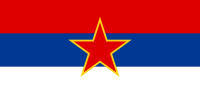League of Communists of Serbia Савез комуниста Србије Savez komunista Srbije | |
|---|---|
 | |
| Abbreviation | KPS (until 1952) SKS (after 1952) |
| Secretary/President | See list |
| Founded | 8 May 1945 |
| Dissolved | 17 July 1990 |
| Preceded by | Provincial Committee for Serbia |
| Succeeded by | Socialist Party of Serbia |
| Headquarters | Ušće Tower, Belgrade |
| Youth wing | League of Socialist Youth of Serbia |
| Ideology | Communism Marxism-Leninism Titoism |
| National affiliation | League of Communists of Yugoslavia[a] |
| Colours | Red |
| Party flag | |
 | |
The League of Communists of Serbia (Serbian: Савез комуниста Србије, romanized: Savez komunista Srbije, abbr. SKS), known as the Communist Party of Serbia (Serbian: Комунистичка партија Србије, romanized: Komunistička partija Srbije, abbr. KPS) until 1952, was the ruling political party of Serbia from 1945 to 1990. It was the Serbian branch of the League of Communists of Yugoslavia, known until 1952 as the Communist Party of Yugoslavia.
Under a new constitution ratified in 1974, greater power was devolved to the various republic-level branches. In the late 1980s, the party was taken over by a faction endorsing Slobodan Milošević to become leader of the party. Milošević appeased nationalists in Serbia by promising to reduce the level of autonomy within the autonomous provinces of Kosovo and Vojvodina. This policy increased ethnic tensions with the other republics and nationalities. During the early 1990s, the growing ethnic tensions between the republics of Yugoslavia led to the break-up of the federal party.
On 17 July 1990, it merged with several smaller parties to form the Socialist Party of Serbia.[2]
During its existence the League of Communists of Kosovo and the League of Communists of Vojvodina were associated with it as "integral parts."[3]
YouTube Encyclopedic
-
1/5Views:301 61835 3201 379 6981 4917 099
-
The Death of Yugoslavia 1990's! BBC Complete Documentary
-
The Death of Yugoslavia! BBC Complete Documentary (Part 1/2).
-
The Breakup of Yugoslavia
-
General Ratko Mladic Entering Srebrenica July 1995! [Bosnia War Documentary]
-
Draza Mihajlovic VS Josip Broz Tito! [Full Documentary]
Transcription
Party leaders
- Blagoje Nešković (1941 – 1948)
- Petar Stambolić (1948 – March 1957)
- Jovan Veselinov (March 1957 – 4 November 1966)
- Dobrivoje Radosavljević (4 November 1966 – February 1968)
- Petar Stambolić (February 1968 – November 1968)
- Marko Nikezić (November 1968 – 26 October 1972)
- Tihomir Vlaškalić (26 October 1972 – May 1982)
- Dušan Čkrebić (May 1982 – 17 May 1984)
- Ivan Stambolić (17 May 1984 – May 1986)
- Slobodan Milošević (May 1986 – 24 May 1989)
- Bogdan Trifunović (24 May 1989 – 16 July 1990)
Congresses


- I. (Founding) Congress – 8–12 May 1945
- II. Congress – 17–21 January 1949
- III. Congress – 26–29 April 1954
- IV. Congress – 4–6 June 1959
- V. Congress – 11–14 May 1965
- VI. Congress – 21–23 November 1968
- VII. Congress – 23–25 April 1974
- VIII. Congress – 29–31 May 1978
- IX. Congress – 1982
- X. Congress – May 1986
- XI. Congress – December 1989
- XII. (Extraordinary) Congress – July 1990
See also
- History of Serbia
- League of Communists of Yugoslavia
- List of leaders of communist Yugoslavia
- Socialist Federal Republic of Yugoslavia
Notes
References
- ^ Biondich, Mark (2011). The Balkans: Revolution, War, and Political Violence Since 1878. Oxford: Oxford University Press. p. 180. ISBN 9780199299058. OCLC 718575569.
- ^ Yugoslavia The Old Demons Arise, TIME Magazine, 6 August 1990
- ^ William B Simons & Stephen Write (Ed.). The Party Statutes of the Communist World. The Hague: Martinus Nijhoff Publishers. 1984. p. 489.

